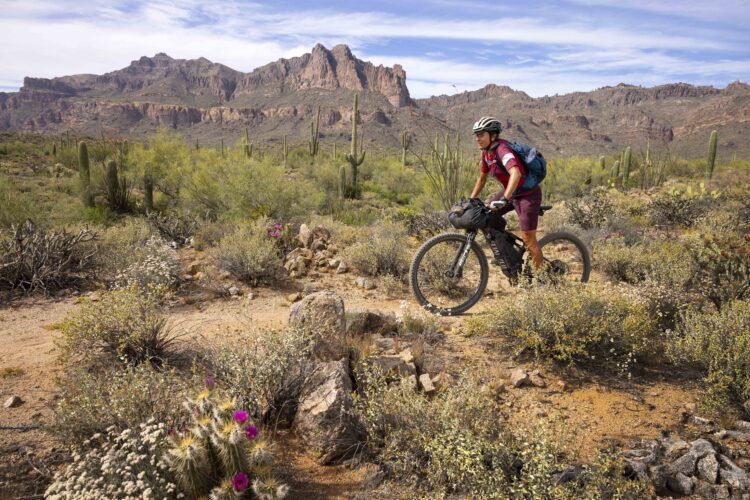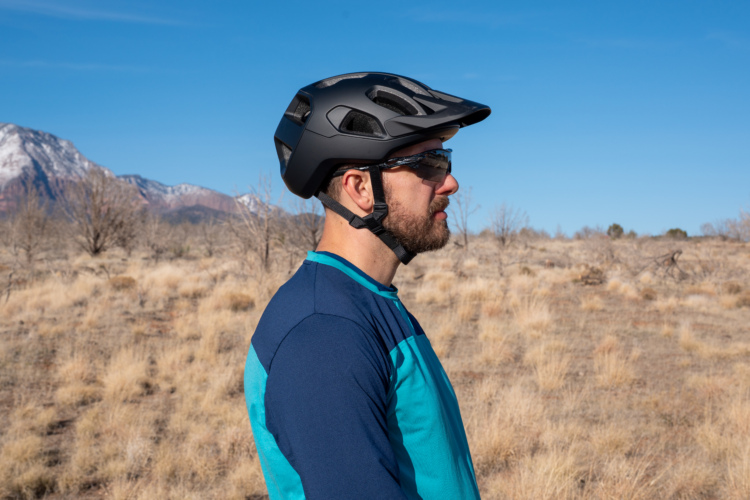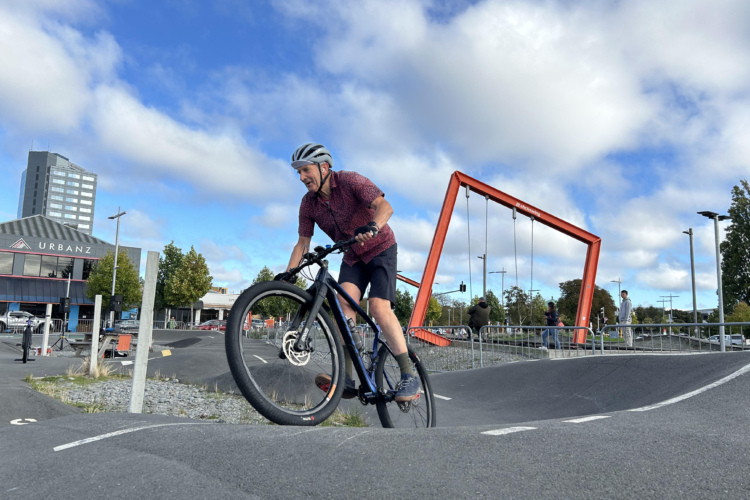
In 2018, endurance cyclist Jenny Graham set the women’s world record for the fastest known time (FKT) circumnavigating the earth on a bicycle unsupported. Graham reached her finish line in Berlin, Germany, 124 days after starting in the same spot.
Another ultra-endurance cyclist, Lael Wilcox, is racing the clock, hoping to best Graham’s FKT by two weeks. If all goes as planned, Wilcox will successfully ride her bike around the world — a distance of 18,000 miles — in just 110 days.
To accomplish this task, Wilcox must pedal an average of roughly 164 miles per day for 15 and a half weeks.
If you haven’t heard of Wilcox before, know this: she’s indisputably one of the greatest ultra-endurance athletes of our time. Her website is littered with ridiculously long races she has participated in, leading up to the around-the-world record-setting attempt.
Wilcox has claimed numerous FKTs on long-distance bikepacking routes and innumerable first-place finishes. She has set the women’s FKT on the Arizona Trail and currently holds the FKT on the 2,745-mile Tour Divide route, among others.
While we wanted desperately to chat with Wilcox and hear about her journey so far, as you can imagine, we couldn’t get in touch with her. However, Wilcox has been documenting her journey through a series of daily podcasts where she keeps listeners updated on her FKT attempt.
If Wilcox can accomplish her 110-day goal, she’ll land herself in the Guinness World Records.

The rules she must follow
There is no established course for circumnavigating the world on a bicycle. Cyclists can set their own route but must follow a handful of rules to attempt a successful circumnavigation.
“There are only about five rules to go after the Guinness World Record,” Wilcox explained via her podcast. The first rule Wilcox must follow is that she must start and end at the same place. Wilcox began her journey on May 26th, 2024, from Chicago, Illinois, and, therefore, must end her attempt 18,000 miles later in Chicago.
The second rule is that racers must ride either east or west, ruling out potential routes such as the Pan-American Highway. Wilcox’s start in Chicago had her riding east.
Thirdly, a racer must take commercial transportation between continents. While racers may choose to complete the circumnavigation solo or with a support team, no private jets or charters can be a part of the support team.
When racers build an east or west route, there is an understanding that some backtracking may need to be done in particular areas. Natural obstacles such as mountains, lakes, and rivers may need to be ridden around, or specific areas avoided altogether. However, to ensure racers aren’t taking advantage of adding mileage by backtracking, the fourth rule is that the rider cannot zig-zag back and forth more than 300 miles.
The fifth rule is that the racer must cross two opposite sides of the globe, ensuring that they actually circumnavigate the earth. Wilcox’s route takes her through Madrid, Spain, and Wellington, New Zealand.
“One additional rule is your full travel has to be about 40,000 km – so 25,000 miles – including your riding and then your commercial travel between riding points,” Wilcox shared.
FKTs vs. Guinness World Records
Graham currently holds the women’s FKT for cycling around the world unsupported as well as the Guinness World Record for “fastest circumnavigation by bicycle (female).” However, the Guinness World Records don’t distinguish between supported and unsupported rides in the way that most FKTs are recorded. Mark Beaumont holds the Guinness World Record for “fastest circumnavigation by bicycle (male)” of 78 days, 14 hours, and 40 minutes, but this was a supported ride.
If Wilcox can reach her 110-day goal, she’ll earn the women’s Guinness World Record and women’s unsupported FKT. However, if she can shave off a few more days, she could potentially earn the unsupported FKT regardless of gender.
Unfortunately, mountain bike FKTs are not tracked as closely as trail running FKTs, and determining what time is truly the unsupported FKT is a bit confusing. According to the Wikipedia article on the topic, Jenny Graham is listed as holding the unsupported FKT at 124 days, 10 hours, and 50 minutes. However, lower down in the article, an unsupported 2012 ride by Mike Hall is recorded that would qualify as the unsupported FKT for all genders. According to that information, “Hall recorded a time of 107 days 2 hours 30 minutes, which was not ratified by Guinness World Records.” This contradicts the information listed higher up in the Wikipedia article.
It appears that if Lael can come in three days under her 110-day goal, she might even achieve an unsupported around the world FKT regardless of gender.
The road less traveled
Wilcox acknowledges that the rules a racer must follow to successfully circumnavigate the world leave the doors open for many different route possibilities. If most of us were up to the task of riding around the world in just 110 days, we would choose the most direct and flattest route possible.
Not Wilcox.
“[That] sounds really boring,” Wilcox said on her podcast. Rather than just putting her head down and grinding out the miles, Wilcox hopes to experience the landscapes and cultures of the different places she will pass through.
It would also make sense for Wilcox to attempt Graham’s 2018 route but in a faster time. However, several factors played into Wilcox choosing a different route, including a changing political climate. Graham’s 2018 circumnavigation had her pedaling through quite a bit of Russia, something Wilcox said she could likely get permission to do, but ultimately wasn’t a good idea.
“I’m not trying to blast through these places,” Wilcox said. “I wanna go to places where I’m welcomed, where it’s an okay place for me to ride.”
The European stretch proved to be the most challenging leg to plan. Many countries and possible routes lay before Wilcox and the team helping her plan the route through Europe. After much consideration and many drafts, a route was set, covering nearly 5,000 miles spanning 29 days through the European continent.
Wilcox landed in Portugal on June 2nd, pedaling next to Spain. From Spain, it was on to France and then The Netherlands. After The Netherlands, Wilcox crossed into Germany, Switzerland, Italy, Austria, and Croatia. From Croatia, Wilcox pedaled to Bosnia and Herzegovina, then to Serbia, Bulgaria, and Turkey. After a week of pedaling through Turkey, Wilcox crossed into Georgia, where she would end her European leg and head to Australia.

Where in the world is Lael Wilcox?
At the time of this writing, Wilcox had made her way to Pemberton, Australia, and completed her 39th day. As far as miles go, she has completed one-third of her journey, with 6,261 miles behind her.
She has also climbed an astonishing 252,125 feet of elevation so far, a feat many of us won’t accomplish in a year of riding. Her most recent leg of the journey — Bunbury to Pemberton, Australia — had Wilcox riding 184 miles and gaining an impressive 6,237 feet of elevation.
The end of Wilcox’s journey has her spending a significant amount of time riding through Alaska, her home state. “I’ve ridden a lot in Alaska — it’s my home — so I’m looking forward to having that toward the end,” Wilcox said on her podcast. “Something familiar — maybe the wildest place, but also the most familiar for me, so that will be cool.”
You can follow Wilcox’s journey via her podcast or the daily log on her website. Wilcox’s wife, Rue Kaladyte, is helping to document the journey through social media and plans to release a film about the adventure once Wilcox completes the circumnavigation.





















2 Comments
Jul 8, 2024
Jul 9, 2024